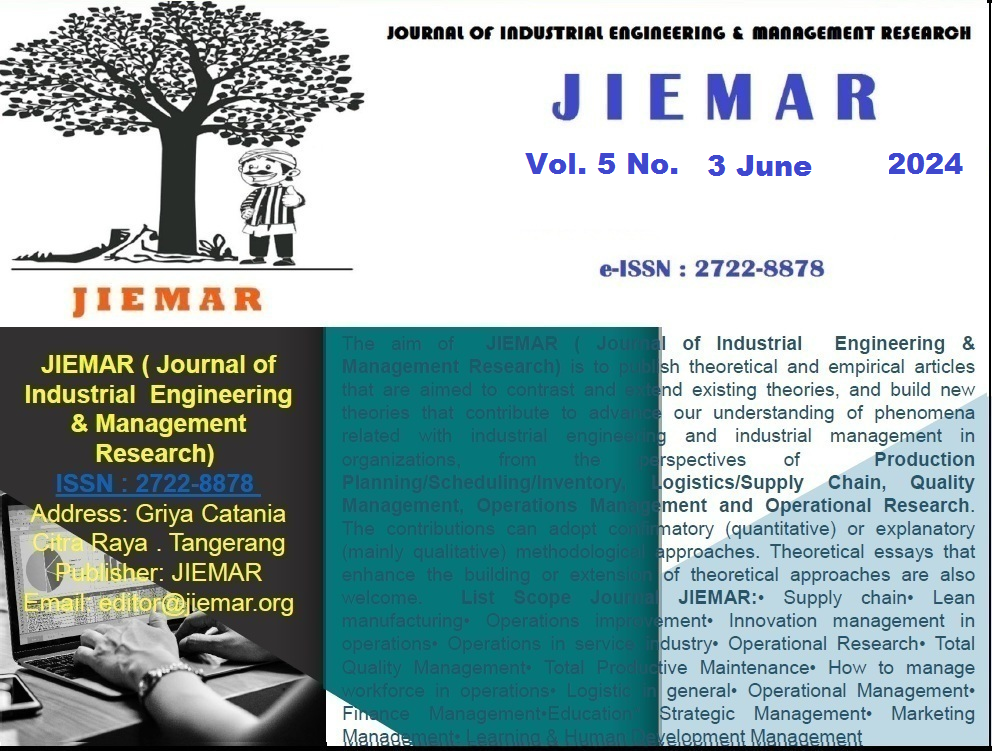HUMAN RESOURCE MANAGEMENT PRACTICES FOR EFFECTIVE ORGANIZATIONAL CHANGE : A REVIEW OF RESEARCH IN WESTERN AND NON-WESTERN COUNTRIES
Abstrak
The success of an organization or company depends on the performance of the employees produced, whether the performance of the employees produced is good or bad, good or not. Because employees are the driving force for a company itself. Employees who produce good performance will have a direct impact on the progress obtained by the company. Performance is a problem that is often discussed. employee performance or usually in other words employee performance is the work performance or achievement that a person achieves in a genuine way. With high employee performance, it can be a competitive advantage of the organization or company. If the company competes using human resources, the results that will be obtained are two, namely competitive advantage and comparative advantage, because the existence of this advantage will certainly make it difficult for competitors to imitate what we produce (Tohardi, ). Employee performance is the result of quality and quantity work produced by employees or also called behavior that is displayed in accordance with the responsibilities given to the employee himself (Murty and Hudiwirnasih,). Performance is also the result of work produced or given by an employee that is directly related to the duties and responsibilities given by the company (Mangkunegara,). Therefore, with good employee performance, it is hoped that the company will continue to provide appropriate motivation so that other companies can judge that the company has quality performance. Employee performance is closely related to the motivation that the organization applies or already exists in the company. The motivation provided in an organization is expected to help or have a good impact on its employees, especially in creating high performance. Companies that can apply and provide motivation according to the needs of their employees will certainly affect their work performance and performance. As for motivation as one of the important things that must be given to employees, the lack of motivation provided can have an impact on their performance, such as increased absenteeism and decreased employee involvement in doing their duties. Low employee morale can help the company's achievement to meet its goals take longer and disrupt the company's profitability. Therefore, companies must pay attention to the motivation of employees. Motivation is one of the important roles for human behavior and performance, from the level of motivation in individuals and teamwork in a person can affect all aspects of organizational performance. The total success of organizational projects depends on the commitment of the team, which depends directly on their level of motivation In the Hawthrone Study conducted by Elton Mayo in the year and, the need for employees to get higher job performance has been found not only in giving intensive money, but also shows that employees are influenced by external elements as well and how they can organize themselves in informal groups. The right motivation can encourage employees to do as much as possible in doing their duties, with high motivation encouraging individuals to commit to their work. Motivation is closely related to the attitudes and behavior of each individual, motivation itself can also be interpreted as a condition in a person's personality so that the person is encouraged or wants to carry out the desired activities and activities Motivation can be influenced by several aspects such as employee loyalty, life demands, targets to be achieved and other factors. Sometimes work motivation also has a negative effect on employees because of the motivation to compete to be the best employee in a way that is not good, such as damaging the character of the employee's coworkers. Therefore, high motivation affects the performance of the organization itself and also improves one's own performance including ability, expertise and ethics.Based on the description above, the researcher sees the importance of the Human Resources (HR) factor in supporting the practice of Effective Organizational Change so that workers or employees are ready for the Company's future challenges which involve changes to achieve the goals to be achieved.
Referensi
Al-Nakeeb AAR, G. M. (2024). Human Resource Management Practices for Effective Organizational Change: a Review of Research in Western and Non-Western Countries. Found Manag, 16(1) : 7-24. doi:10.2478/fman-2024-0001.
Alqudah, I. C.-P.-S. (2022). High-performance human re- source management practices and readiness for change: An integrative model including affective commitment. European Research on Management and Business Economics, Vol.28(1). doi:10.1016/j.ie-deen.2021.100177
Baard, S. R. (2013). Performance Adaptation. Journal of Man-agement, 40(1) pp.48-99. doi:10.1177/0149206313488210
Bani, H. (2021). Human Resources’ Capacity to Drive Organizational Change in Ghana. SSRN Electronic Journal. doi:doi.org/10.2139/ ssrn.3940612
Brown, M. K. (2017). Understanding the Change-Cynicism Cycle: The Role of HR. Human Resource Management. 56(1), pp.5-24. doi:10.1002/ hrm.21708
Choi, M. (2011). Employees' attitudes toward or- ganizational change: A literature review. Human Resource Management, 50(4), pp.479-500. doi:10.1002/hrm.20434
D'Cruz, P. N. (2014). The workplace bullying-organizational change inter- face: emerging challenges for human resource management. The International Journal of Human Resource Management, 25(10), pp.1434-1459. doi:10.1080/09585192.2013. 870314
Garavan, T. S. (2016). Strategic human resource development: toward a conceptual framework to understand its contribution to dynamic capabilities. Human Re- source Development International, 19(4), pp.289-306. doi:10.1080/13678868. 2016.1169765
Gollan, P. K. (2015). Strategic HRM and devolving HR to the line: Cochlear dur- ing the shift to lean manufacturing. Asia Pacific, Journal of Human Resources, 53(2), pp.144- 162. doi:10.1111/1744-7941.12055
Karan, P. (2004). The nonwestern world: Envi- ronment, development and human rights: Routledge.
Lucia-Casademunt, A. C.-M.-C. (2018). The role of human resource practices and managers in the develop- ment of well-being. Cross Cultural & Strategic Management, 25(4), pp.716-740. doi:10.1108/ccsm-05-2017-0054
Lucia-Casademunt, A. C.-M.-C. (2018). The role of human resource practices and managers in the develop- ment of well-being. Cross Cultural & Strategic Management, 25(4), pp.716-740. doi:10.1108/ccsm-05-2017-0054
Naeem, M. (2020). Understanding the role of social media in organizational change implementation. Management Research Review, 43(9), pp.1097-1116. doi:0.1108/mrr-07- 2019-0336
Peters, P. P. (2014). Enjoying New Ways to Work: An HRM-Process Approach to Study Flow. Human Resource Management, 53(2), pp.271290. doi:10.1002/ hrm.21588
Pluta, A. R. (2016). Holistic approach to human resources and organizational accelera- tion. Journal of Organizational Change Management, 29(2), pp.293-309. doi:10.1108/jocm-11-2014-0210
S, N. (2008). Pengembangan Sumber Daya Manusia Dan Aplikasinya. . 1.
Shipton, H. B. (2012). HRM, Organizational Capacity for Change, and Performance: A Global Perspective. Thunderbird International Business Review, 54(6), pp.777- 790. doi:10.1002/tie.21503
Supriharyanti, E., Sukoco, B.M.. (2022). Organiza- tional change capability: a systematic review and future research directions management Research Review. ahead-of-print(ahead-of-print). doi:10.1108/mrr-01-2021-0039
Syamsuri, A. S. (2019). Organiza- tional transformation strategy: Perspective of hrm theory. International Journal of Scientific and Technology Research, 8(10), pp.2251-2256.
Tummers, L. P. (n.d.). Connecting HRM and change management: the importance of proactivity and vitality. Journal of Organizational Change Management, Vol. 28(4), pp.627-640. doi:doi.org/10.1108/jocm- 11-20130220
Walker, H. A. (n.d.). Factors influencing organizational change efforts: An integrative investigation of change content, context, process and individual differ- ences. Journal of Organizational Change Management.







